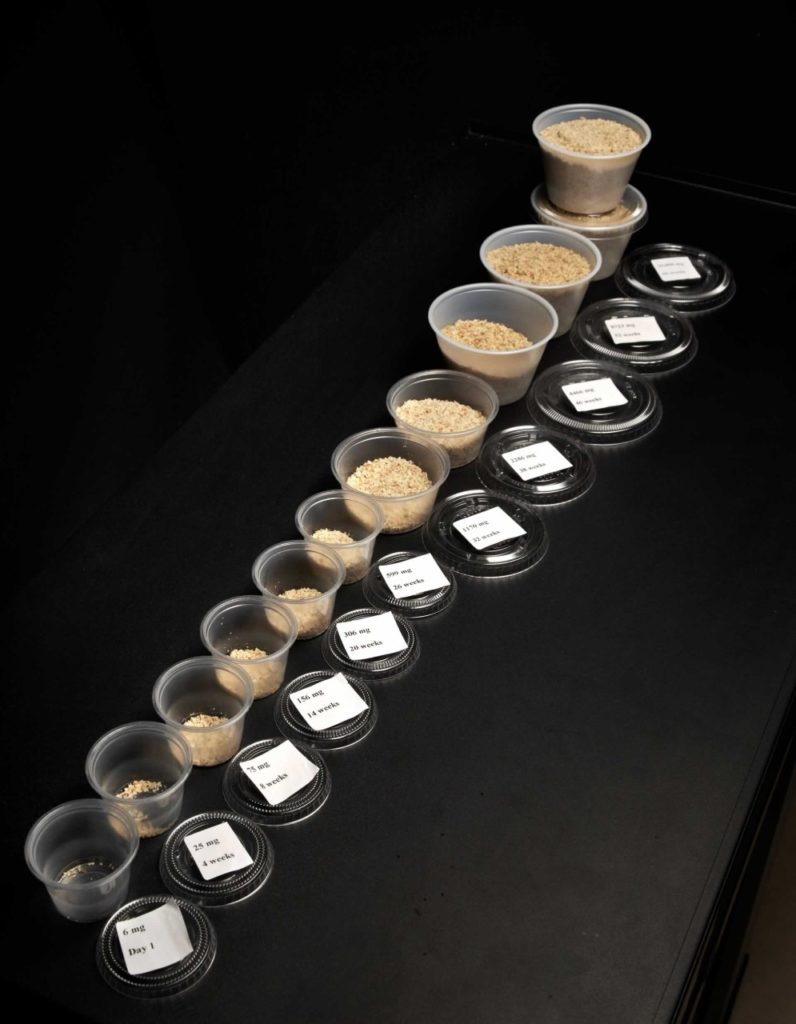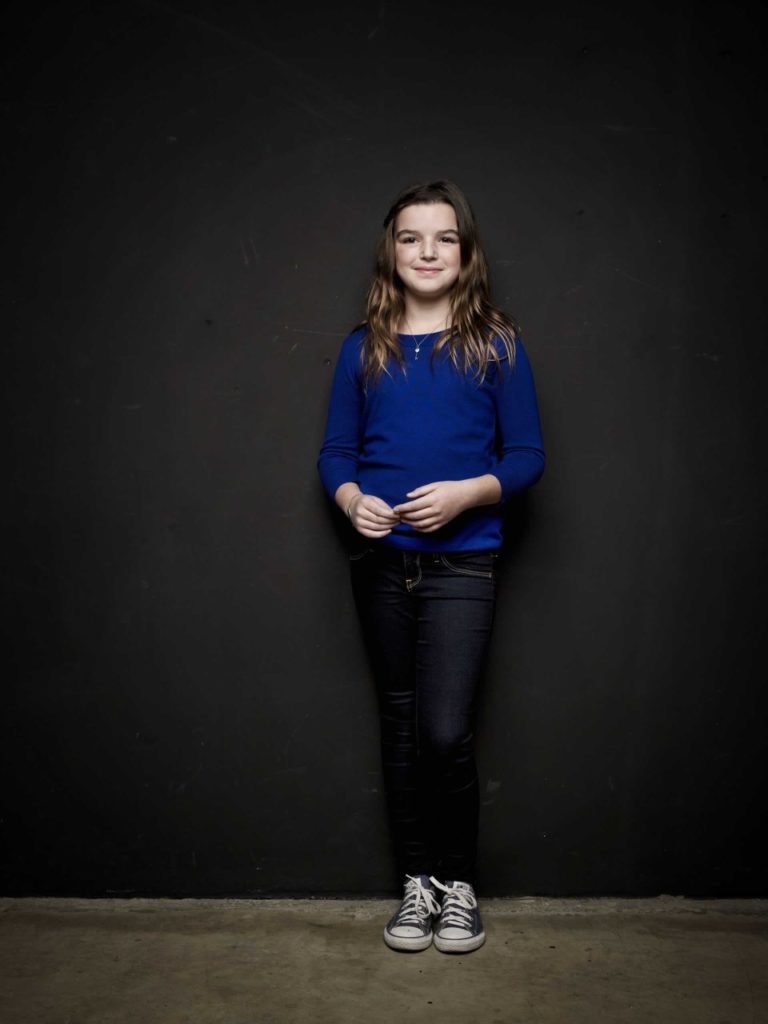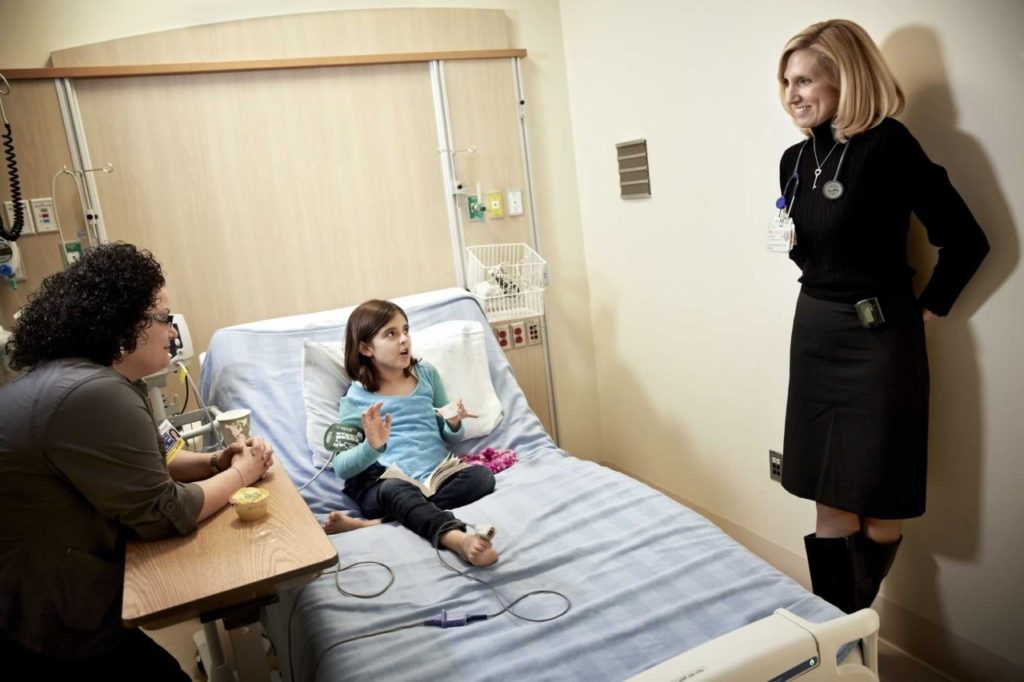I can eat it
Taking a bite out of food allergies

Unlike other life-threatening conditions, the people they affect are completely healthy unless they are exposed to the allergen. They and their families live a life of unremitting worry, with the constant mental refrain that any mistake can be a fatal mistake. And there are always mistakes
For Michelle Sandberg, MD, and Marc Bodnick, it was the time their 9-year-old daughter Maya went on a skiing trip with her cousin. Her aunt let Maya pick out some malt balls from a candy bin after checking with the staff that none of the candies contained nuts, which Maya was allergic to. But the candies had been contaminated, and Maya’s face began to swell, her throat hurt and she vomited. Her aunt, an ER doctor, dosed her with Benadryl and she conked out for 14 hours. Kim Yates Grosso and Andy Grosso recall the time their 8-year-old daughter Tessa almost died when she ate a spring roll with “rice” noodles that turned out to be made of wheat, which she was allergic to, and she began to lose consciousness.
When my son, Kieran, was a toddler he got hold of a cookie that contained egg and nuts, both of which he was allergic to. I grabbed it out of his hand just as he began to put the cookie in his mouth and rinsed his mouth out with water. I mistakenly believed then that an allergic reaction would be in proportion to the exposure to the allergen and, since he hadn’t bitten down on the cookie, I thought if he had any reaction, it would be slight. But as a precaution I decided to drive him to the hospital and sit in the parking lot. He was screaming energetically as we pulled out, but on the way he quieted and began to seem glazed. His face was white, spotted with crimson hives, and his lips were oddly blue. I didn’t know then that blue lips are a sign of oxygen deprivation, but I saw the terrible hives were spreading down his trunk and I stabbed him in the thigh with an EpiPen — an adrenaline-loaded syringe. (Adrenaline — also called epinephrine — interrupts the allergic reaction by relaxing airways and tightening blood vessels.)
I promised myself that day that nothing — nothing, nothing, nothing — would ever cross his lips again unless I had prepared it myself and, when he was released from the hospital the next day, I threw out all the processed foods in the house. But it was not his last reaction — by the time he was 3, he had needed an EpiPen three times.
In a severe allergic reaction known as anaphylaxis, the body misidentifies the protein of a harmless food as protein of a pathogen. The immune system mounts an attack that spirals out of control, turning into a terrible, self-sustaining feedback loop that — unless interrupted by a shot of epinephrine — causes tissues throughout the body to swell until the airways close and the heart and lungs fail.

Currently, about 8 percent of children in the United States and about 2 percent of adults have diagnosed food allergies. It’s a mysterious epidemic. The rate of food allergies has more than doubled over the past decade and appears to be rising, with the rate highest among preschoolers. (Many more people self-identify as food allergic, but they are actually suffering from food intolerances or sensitivities.) An estimated one-quarter of people with food allergies will have an episode of anaphylaxis in their lifetime. These rarely result in death — the fatality rate is hard to quantify because such deaths are often coded as cardiac arrest — but they are the cause of 90,000 emergency room visits a year. Until recently, no effective therapy for the problem existed.
Maya, Tessa and Kieran were rescued from this life by being among the first children to be treated in a medical trial at Stanford of a treatment called oral immunotherapy, or OIT, led by Kari Nadeau, MD, PhD, associate professor of pediatrics at Stanford and an immunologist at Stanford Health Care and Lucile Packard Children’s Hospital Stanford. The treatment involves retraining the immune system through eating the allergen, beginning with microdoses and slowly increasing until the patient can safely eat a full serving of the food. Nadeau and her colleagues have recently discovered that the treatment changes the way patients’ genes function.
For decades, immunotherapy has successfully treated environmental allergies (giving injections of cat dander, tree grass and so forth), but has been considered too risky to try with food allergies. However, in the 1980s researchers in Europe experimented with food allergies and, in the past decade, trials conducted at Duke, Johns Hopkins, the Mount Sinai School of Medicine and other places showed that children could be safely desensitized to peanut, milk and egg. Each of these trials had involved desensitizing children to a single food at a time, yet a third of people with allergies suffer from more than one allergy.
In April 2009, Kim Yates Grosso attended a lecture on food allergies by Nadeau. Afterward, she asked Nadeau what she could do for her daughter Tessa — severely allergic to milk, wheat, eggs, nuts, shellfish and some other foods. To desensitize Tessa to her major allergens one by one would take more than a decade. Nadeau promised to help her — and she did.
The two women worked together to raise the money to conduct a trial of OIT in which patients would be desensitized to up to five foods simultaneously. Yates Grosso led a volunteer coalition — the SAFAR (Stanford Alliance for Food Allergy Research) Community Council. The council raised 95 percent of the money for the trials, with the balance made up by grants from the National Institutes of Health. So far, over 300 patients have undergone the therapy at Stanford; unlike other trials, Nadeau accepted both adults and pediatric patients. (Another 1,200 patients are on the waiting list.)
We began oral immunotherapy when Kieran was 2. The first doses — made from the protein of the allergens — are so small they look like sprinkles of cinnamon. Kieran, for example, began at 1.2 milligrams of each of his allergens: 1/7000 of an egg; 1/200 of a peanut, 1/200 of a hazelnut, 1/250 of an almond and 1/300 of a cashew. Every two weeks or so, he would return to the hospital for an “updose” in which he would try to eat a slightly larger amount. Every day at the same time, he would eat a dose at home and then we would anxiously monitor him for reactions for two hours. Like almost all the patients, he had reactions: He got hives on his face, his eyes became itchy, his tongue became swollen or he vomited. If he reacted, we would stay on that dose an extra few weeks until his body adjusted to it. (Reactions severe enough to use an EpiPen are rare; out of 309 patients, only 15 had a reaction in which an EpiPen was used.)
Tessa was in smaller, multiallergy OIT trial in which patients received injections of an asthma drug, Xolair, that suppresses a critical antibody in anaphylaxis known as IgE. Because of this, Tessa was able to complete a treatment in just four months. After about two years of OIT, Maya switched to a Xolair trial and finished her treatment in eight months.
We pinched ourselves at Kieran’s fourth birthday, when we were able to serve chocolate cake made with eggs; on his first birthday, before we knew he had an egg allergy, a few bites of cake had put him in the hospital. Like most allergy parents, I had come to think of eggs and nuts — formerly favorite foods of mine — as positively evil and shunned them myself, even when I was traveling. Then suddenly the curse was lifted: We took down the sign on our front door forbidding them and we served peanut butter on toast for breakfast, almond and cashew butter sandwiches for lunch, hazelnuts for snack and eggs for dinner every night.
Indeed, we had to serve them (this is the catch of the treatment) because the patient needs to continue eating the food to prevent a return of the allergy. Suddenly the food that has always been strictly avoided has to be eaten every day — a surreal state of affairs. Patients must initially eat full servings of the food every day (the program is now experimenting with having patients eat them every other day instead). Eventually however, when their blood work and skin testing shows no traces of the allergy (which happens sometime between six months and three years), they can consume a much smaller amount — say a few peanuts, or the amount of egg in a muffin.

For some kids the food that once was poisonous to them still tastes like poison. Tessa, now 11, finds milk and eggs revolting — she will eat them only in the form of ice cream and egg chips. For a long time, Maya, 10, could consume her nuts only in a vanilla frozen yogurt and pineapple smoothie, but she eventually graduated to eating them straight.
“Nuts are hard to swallow,” she says. It could take her up to an hour to do so, and sometimes she would spread out eating the nuts over the entire day. “I chew them into a paste and then swallow them with water.”
When I say that I don’t find nuts hard to swallow, she thinks it over and says that, although she has been eating them with no physical allergic reaction for about nine months, “My brain makes my mouth not want to swallow them — it still feels like my throat is closing up.”
Because of kids’ aversion to their former allergens (not to mention the general difficulty of getting kids to eat anything their parents want them to), trials at other centers in the United States and Europe have lost up to a third of their patients. Nadeau and her team have gone to extraordinary lengths to avoid this. They bond with the patients and their families and are accessible to them day and night. When one boy decided he would take his dose only if Tina Dominguez, the program’s beloved physician assistant, would stay on the phone with him, she did it. Families can join a support group and work with a therapist to treat anxieties about eating the foods and a nutritionist to find creative ways to eat the food, such as placing nuts under the cheese on a pizza. Out of 309 patients, only 10 dropped out. (Three moved away, two suffered from unrelated health problems, two found taking the dose caused the child or their parent too much anxiety, and three were terminated because they failed to take their doses more than six days in a row.)
“For everyone who has stayed in the study, the treatment has been 100 percent successful,” says Nadeau. “It turns out that everyone’s immune system is capable of adapting — and surprisingly, it is as true of adults as children.” She and her team now have an eight-year study of OIT — the longest record in the United States — in which they found that everyone who was compliant with the treatment and continued to eat the foods has kept their allergies from returning.
What happens if the patients stop eating the foods altogether? Nadeau recently published the results of a withdrawal study, where 20 formerly peanut-allergic patients who had completed two years of OIT and were able to eat a full serving (1 tablespoon of peanut butter or 20 peanuts) without any reaction stopped eating peanuts altogether. After three months, more than half (13 out of 20) had regained the allergy to peanuts, although their reactions were no longer as severe. By six months, almost everyone (17 of 20) had regained the allergy.
Why? How does OIT work — and why doesn’t it last without continuous exposure? Is it possible to understand at a molecular level what causes food allergies, and how OIT changes those processes?
These are among the questions Nadeau and others at Stanford have been exploring. She is in the process of building an allergy research center that will bring together researchers and clinicians, geneticists, engineers, chemists, psychologists and nutritionists. Since October 2013, $14 million has been raised toward the center’s goal of $38 million.
“I am excited about the center because there is enormous clinical need,” says Lloyd Minor, MD, dean of Stanford’s medical school. “This profound increase in the incidence of serious food allergy that has occurred in a relatively short space of time is fascinating and deeply concerning at the same time.
“It is often times said and it’s true that Stanford nurtures innovation like no other place does.” Minor believes that “innovation today extensively builds on collaboration. One reason I’m so excited about the center is that, with Kari’s leadership, the center is establishing and leveraging interactions with departments around the entire university in truly innovative ways,” and he thinks the interdisciplinary approach is the best way to crack the code of food allergies.
The center will also research and treat food sensitivities and intolerances. “Our researchers are trying to understand why some people are skewed toward autoimmunity, like gluten intolerance or celiac, while others are skewed toward allergy,” Nadeau says. “Both involve misdirected immunity — one is dysfunctional and leads to autoimmunity, and one is dysfunctional in a very different way and leads to food allergy.”
Nadeau and her colleagues are also working on a type of immunotherapy that circumvents the need to eat the allergens. Patients receive injections in which the food protein — cloaked in a nanoparticle that will fool the body and thus avoid anaphylaxis — travels directly to the lymph nodes and re-educates the immune system. This approach has been tried successfully in Switzerland and Canada to treat allergies to grass pollen and cat dander, respectively.
Another focus of Nadeau’s work has been the development of a predictive food allergy test. Pilot studies have found that the test — which is being developed in collaboration with the laboratories of professor of microbiology and immunology Stephen Galli, MD, and professor of genetics Leonore Herzenberg, PhD — can identify food allergies with 95 percent accuracy using just three drops of blood from a newborn. The hope is that this test will eventually not only identify an allergy, but also predict how severe that allergy will be.

An environmental connection?
Food allergies are thought to be largely genetic (one study with twins found them to be about 70 percent genetic and 30 percent environmental). The environmental theories include exposure to toxins, pollution, the Western diet and excessive cleanliness — “the hygiene hypothesis” — that has deregulated the immune system. But if food allergies are largely genetic, than how has there been such a rapid increase in food allergies?
Genetic changes used to be believed to take place only through natural selection, over vast periods of time. But the new field of epigenetics has discovered that, although the genetic code itself is fixed at birth, the environment can radically modify how genes behave through chemicals that attach themselves to the genes. Moreover, these acquired epigenetic changes can actually be passed on to later generations.
“What we discovered is that allergy treatment causes changes at the epigenetic level,” Nadeau says.
“As we learn the impact of these epigenetic influences we are really starting to see the richness and diversity of the interplay between our genetic makeup and our environment and the other things that impact the way our genes are expressed,” comments Minor, “and that’s fascinating scientifically and it’s incredibly important clinically.”
Nadeau and her colleagues focused on a type of white blood cell known as regulatory T cells, or Tregs. Tregs are called “peacekeeper” cells because they modulate the immune system and allergic response (preventing autoimmune disease, for example). Treg cells suppress other cells that are overactive or inflamed — a system that dramatically fails in the case of anaphylaxis. Her lab examined a gene within these cells called FOXP3. In the case of allergic subjects, she discovered FOXP3 had been disabled because it had become coated with methyl groups. Methyl groups (groups of three hydrogen atoms bonded to a carbon atom) affect different genes differently, but in the case of FOXP3, the methyl groups suppressed the gene, rendering it useless.
In a recent study, Nadeau compared blood samples from peanut-allergic patients who had been desensitized through OIT with blood from peanut-allergic patients who had not undergone the therapy. The untreated group had a high level of DNA methylation in the FOXP3 gene, but the patients who had undergone OIT had a low level. The therapy had caused the gene to demethylate and become active again. Indeed, the level of methylation in patients who had undergone OIT was so low as to be indistinguishable from that of people who had never been allergic.
Other work by Nadeau and her colleagues has found that environmental stressors such as tobacco smoke and pollution can cause FOXP3 to methylate.
People who have food allergies have a 65 percent chance of passing those allergies to their children. Will OIT change that? In animal models, the epigenetic changes last three generations — for good (in the demethylated FOXP3 gene), or for bad (exposure to toxins such as cigarette smoke and pollution). Perhaps Tessa and Maya and Kieran will pass the de-methylated FOXP3 to their children, and spare them the burdens of their experiences.
Fear-free eating
Nadeau recently published a study that attempted to document the vast improvements in quality of life of patients and their families after they were desensitized. Of the 75 families who filled out a questionnaire, over 92 percent reported a significant improvement in their quality of life.
Kieran’s allergies were the deepest worry my husband, Michael, and I had ever faced that actually evaporated. “You’ll have to figure out something else to worry about now,” a friend joked. But we didn’t; it turns out our other worries aren’t as worrisome as the fear that our child may die because we were insufficiently worried, as it were, and failed to protect him. The long vigil was over.
For Kieran completing the therapy meant no longer being excluded from the food at every preschool party and gathering. For Maya it meant being able to go to sleep-away camp with her bag of nuts and eat the same food as the other campers. For Tessa it meant she was able to go on an overnight trip and feel safe being away from her family.
“She’s a completely different kid and we are a completely different family,” Tessa’s father says. “She has less anxiety, she’s more confident, more social.” For the first time, he and his wife are able to go out by themselves — something they never used to do because they couldn’t trust a babysitter with Tessa.
“Every single time she walked out the door I never knew if I’d ever see her again,” he says. Tessa didn’t feel safe either — she was afraid whenever she had to leave her family. “Now she hops out of the car with her backpack and tennis racket and runs into school without looking back,” he says.
Tessa still has some allergies and all patients are told to continue to carry an EpiPen, even after completing the therapy (rare reactions have been reported). One recent morning, Tessa couldn’t find the EpiPen kit she normally takes to school. Her mother was disquieted to see Tessa’s old desperation resurface as she hunted for it, the emotions of the allergy experience still so powerful for her.
When asked if there were things they would miss about the OIT process, none of the kids hesitated. They would miss spending time with Dr. Kari, Dr. Sharon, Tina and the other staff, and being able to pick out presents from the giant present bucket. They would miss the extra time with their parents — for many children it was the only time they could recall being alone with both parents without competition from siblings. “And iPad time,” Maya adds, smiling, as updoses were a time her parents relaxed the usual strictures.
The kids got all the doting, praise and petting that they would get if they were being treated in the hospital for a chronic illness — except they weren’t sick so they were able to enjoy it. There were the occasional dreaded blood draws and prick tests, but in most of the updoses all they had to do was eat some protein powder mixed in applesauce or custard to be heroes. “We were the pioneers,” Maya says, “the ones that paved the yellow brick road.”
“I wish I could be in the trial,” Kieran’s twin sister, Violet, says.
Kieran says, “I wish I could be in the trial forever.”
Learn more about food allergies at http://med.stanford.edu/allergyandasthma.html
